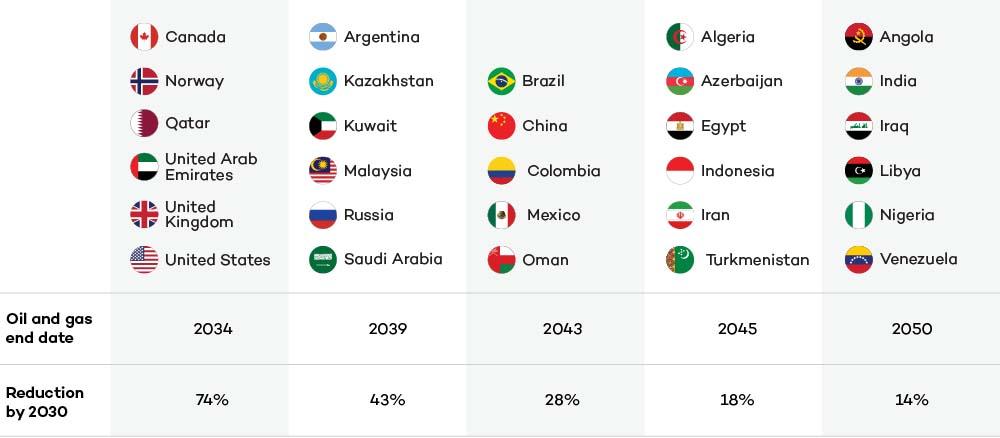Countries Must Phase Out Oil and Gas Production—and Quickly
But How Fast Is Fast Enough?
How fast do we need to phase out fossil fuels to achieve the goals of the Paris Agreement and safeguard our planet’s future? This question is central to planning effective climate action.
IISD commissioned climate scientists at the Tyndall Centre at The University of Manchester to help answer this question, especially in relation to oil and gas production. Their new report suggests a faster timeline than many governments are planning: an oil and gas production phase-out by 2034 for rich countries, and by 2050 for the poorest.
How Does This Tie Into Existing Knowledge?
On a global scale, the Production Gap Report tells us that governments collectively plan to extract twice the amount of fossil fuels than would be consistent with limiting average global temperature rise to 1.5°C. This report shows that global fossil fuel production must start declining immediately and steeply.
We also know from the International Energy Agency (IEA) that there is no room for new oil and gas fields or coal mines to be developed if we are to limit warming to 1.5°C: there is more than enough oil, gas, and coal in the fields and mines that are already in production or under development. Exploring the Intergovernmental Panel on Climate Change (IPCC) scenarios in the IPCC’s Special Report on 1.5°C, we find the same result. IISD will analyze new scenarios from the IPCC when they are released in April 2022 as part of the Sixth Assessment Report due later this year.
But how fast should different countries phase out production, taking into account their economic capacities, levels of development, and degree of dependence on fossil fuel revenues? The Paris Agreement is clear that the pace of countries’ efforts to mitigate climate change will vary according to the principle of “common but differentiated responsibilities and respective capabilities.” Furthermore, developed countries should provide finance and other support to enable developing countries to transition.
There is now a growing consensus that coal should no longer be used to generate power (its largest usage) after 2030 in developed countries and after 2040 or 2050 in developing countries. Starting with a scientific analysis in 2016, this differentiated timeline has been adopted by the Powering Past Coal Alliance and championed by UN Secretary-General António Guterres.
So What About Oil and Gas?
In the new Tyndall Centre report, Phaseout Pathways for Fossil Fuel Production, the researchers aim to shine a similar light on timelines for phasing out oil and gas production. The report’s core principle is that the pace at which countries phase out oil and gas production should be determined by their capacity to fund and enable a just transition for the workers and communities affected. The International Labour Organization describes a just transition as greening the economy in a way that is as fair and inclusive as possible to everyone concerned, creating decent work opportunities and leaving no one behind. This includes through effective social dialogue among all groups impacted, and respect for fundamental labour principles and rights.
The Tyndall report echoes the IEA in finding that no new oil and gas fields can be developed: there is no room for any country, at any income level, to increase its oil and gas production. It further finds that limiting warming to 1.5°C requires the richest countries to phase out oil and gas production by 2034, to give lower income nations longer to replace their income from fossil fuel production. The poorest countries should be given until 2050 to end production, but they will also need significant financial support to transition their economies within that time frame.
There is no room for any country, at any income level, to increase its oil and gas production.
Since the amount of global warming is determined by cumulative carbon dioxide emissions, it is also important that countries start reducing production right away. The richest countries must reduce their oil and gas production by 74% by 2030 compared to current levels, and the poorest by 14%.

If these timelines seem extremely tight, that is because governments have left it so late to reduce greenhouse gas emissions: emissions have continued to grow for over 30 years since the UN Framework Convention on Climate Change was agreed in 1992, and in the 6 years since the Paris Agreement of 2015. As a result, the IPCC’s global carbon budget—the maximum cumulative carbon dioxide emissions we can afford in the future—for a 50% chance of limiting warming to 1.5°C amounts to just over 10 years of current emissions.
One consequence of this urgency is that equity can no longer be addressed only by differentiating the level and speed of mitigation action between countries. Even while richer countries move faster, a major increase in climate finance will be needed for heavily oil-dependent lower income countries to transition their whole economies in less than 30 years. Consider a country like Angola, where more than 40% of government revenues come from oil—that means that 40% of public sector workers rely on oil too for their livelihoods. And it is just as important to enable a just transition for those health workers, civil servants, and others, as it is for oil workers.
What Does This Mean in Today’s Context?
This research was carried out before Russia invaded Ukraine, with tragic consequences for Ukrainians who have lost homes and loved ones. Away from that immediate suffering, the resulting high oil and gas prices have led some to call for replacing Russian supplies by increasing oil and gas production elsewhere. While rising fuel costs will cause economic pain for those that cannot afford to bear it, increasing fossil fuel supply isn’t an effective solution.
Besides the grave environmental consequences, there is very limited potential to increase supplies in the short term, as developing new oil and gas infrastructure can take 5 years or more. To have a near-term impact on energy markets, it is much quicker to reduce demand—such as through insulating homes, improving energy efficiency, or incentivizing public transport—as many governments and the IEA have recognized.
To create security and resilience, we need to accelerate the transition to renewable energy.
The wider lesson is that oil and gas play a destabilizing role in international politics and leave energy consumers exposed to volatile prices. To create security and resilience, we need to accelerate the transition to renewable energy. And we need to manage the process of transition today to support workers and communities who are affected by it and avoid the chaos of an even more rapid shift later on, or of a deteriorating climate.
This new report helps us understand the level of ambition we need. Now it is up to governments to act.
You might also be interested in
Carbon Minefields: Oil and gas exploration surging to pre-Covid levels
Oil and gas exploration is booming despite an agreement at last year’s COP 28 climate summit to transition away from fossil fuels.
July Edition | Carbon Minefields Oil and Gas Exploration Monitor
In June 2024, six governments issued 18 oil and gas exploration licences with embodied emissions of 14.7 MtCO2, led by Russia and China.
Report Calls on Fossil Fuel Producers to Map “Transition Away” in NDCs
With governments due to submit the next generation of NDCs in 2025 a new report identifies five elements countries should include to reflect the outcome of the global stocktake.
No New Fossil Fuel Projects Needed in the Transition to Net Zero
Existing fossil fuel projects are sufficient to meet projected energy demands in a global transition to net zero emissions, finds a new study by researchers from UCL and IISD.
